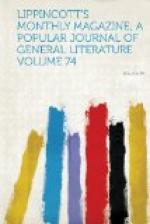It seems, however, grossly unthankful to say that English country-houses lack anything when one has received delightful impressions of what they possess. What is a draughty doorway to an old Norman portal, massively arched and quaintly sculptured, across whose hollow threshold the eye of fancy may see the ghosts of monks and the shadows of abbots pass noiselessly to and fro? What is a paltry piazza to a beautiful ambulatory of the thirteenth century—a long stone gallery or cloister repeated in two stories, with the interstices of its carven lattice now glazed, but with its long, low, narrow, charming vista still perfect and picturesque—with its flags worn away by monkish sandals, and with huge round-arched doorways opening from its inner side into great rooms roofed like cathedrals? What are the longest French windows, with the most patented latches, to narrow casements of almost defensive aspect set in embrasures three feet deep and ornamented with little grotesque mediaeval faces? To see one of these small monkish masks grinning at you while you dress and undress, or while you look up in the intervals of inspiration from your letter-writing, is a simple detail in the entertainment of living in an ancient priory. This entertainment is inexhaustible, for every step you take in such a house confronts you in one way or another with the remote past. You feast upon picturesqueness, you inhale history. Adjoining the house is a beautiful ruin, part of the walls and windows and bases of the piers of the magnificent church administered by your predecessor the abbot. These relics are very desultory, but they are still abundant, and they testify to the great scale and the stately beauty of the abbey. You may lie upon




